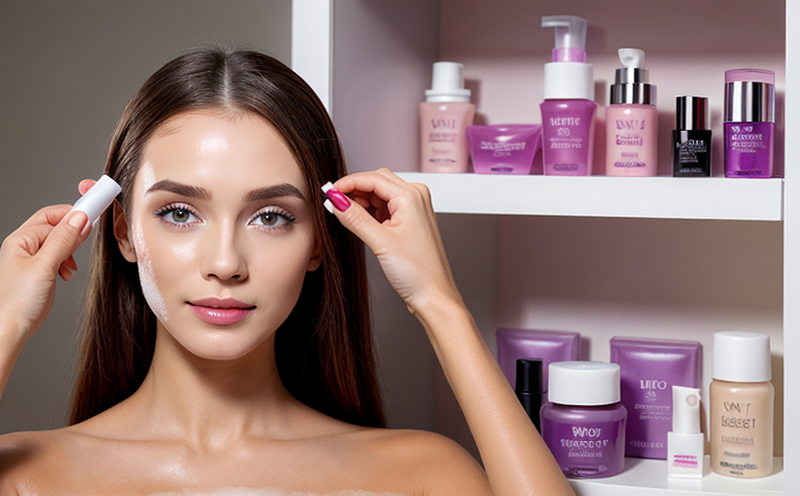Packaging Compatibility Testing in Cosmetics
Testing packaging compatibility is a critical step in ensuring that cosmetic products meet both safety and regulatory standards. Proper packaging ensures that the product maintains its integrity, efficacy, and stability throughout its shelf life. This process involves evaluating how different components of the package interact with each other and with the cosmetics inside. The objective is to prevent any adverse reactions or degradation that could compromise the quality, safety, and effectiveness of the product.
The compatibility assessment covers various aspects including chemical compatibility, physical properties, and performance under different environmental conditions. Chemical incompatibility can lead to undesirable changes such as discoloration, alteration in texture, or generation of harmful byproducts. Physical properties like permeability, barrier integrity, and seal strength are also crucial for maintaining the product's quality.
For instance, certain packaging materials may interact with the active ingredients of cosmetics leading to reduced efficacy or even potential health risks. This interaction can be exacerbated by environmental factors such as temperature, humidity, and light exposure. Therefore, it is essential to conduct comprehensive compatibility tests under controlled conditions that mimic real-world scenarios.
The testing process typically involves selecting appropriate packaging materials based on the specific requirements of the cosmetic product. Factors considered include material type (plastic, glass, metal), thickness, surface finish, and any additional components like lids or closures. Once selected, specimens are prepared by simulating the packaging structure as closely as possible.
Instrumentation plays a vital role in this testing process. Common tools used include gas chromatography for analyzing volatile organic compounds (VOCs) released during interaction; Fourier Transform Infrared Spectroscopy (FTIR) to detect chemical changes; and accelerated aging chambers to simulate long-term environmental effects. The results from these analyses provide insights into potential issues that need addressing before finalizing the packaging design.
The data collected is then analyzed against established standards such as ASTM F2308-17 for evaluating container/closure systems, ISO 15964:2010 regarding cosmetic packaging, and FDA regulations on safety and labeling. Compliance with these guidelines ensures not only product safety but also adherence to international trade requirements.
Properly conducted compatibility testing enhances consumer trust by guaranteeing that the chosen packaging does not negatively impact the cosmetic's performance or pose any risks to users' health. It helps manufacturers make informed decisions about their product development cycle, optimizing resources while minimizing risks associated with suboptimal choices early in the design phase.
By prioritizing packaging compatibility testing early on, companies can avoid costly recalls later down the line due to unforeseen issues like compromised quality or non-compliance with regulatory expectations. This proactive approach not only protects brand reputation but also contributes positively towards sustainable practices by reducing waste and promoting efficient use of raw materials.
Why It Matters
Packaging compatibility testing in cosmetics is essential for several reasons, primarily revolving around safety, quality maintenance, and regulatory compliance. Ensuring that the packaging does not react adversely with the cosmetic content helps maintain product integrity and user safety. For instance, if a container interacts chemically with the formula inside it could lead to degradation or formation of harmful substances which are detrimental to health.
Another aspect is preserving the aesthetic appeal and shelf life of cosmetics. Improperly designed packages can cause changes in color, texture, or viscosity affecting how consumers perceive their favorite products. Moreover, ensuring compatibility reduces instances where packaging fails prematurely leading to waste and increased costs for manufacturers.
Regulatory compliance also plays a significant role; many countries have strict laws governing the packaging of cosmetics including material selection and labeling requirements. Non-compliance can result in fines or even prohibition of sale within those markets. By conducting thorough compatibility tests, companies ensure they stay ahead of changing regulations without sacrificing product quality.
Lastly, customer satisfaction is greatly improved when consumers trust that their purchased products will remain safe and effective over time. This builds long-term loyalty which benefits both the manufacturer and end user alike.
Applied Standards
The testing of packaging compatibility in cosmetics follows several internationally recognized standards designed to ensure safety, effectiveness, and regulatory compliance across various regions. Some key references include:
- ASTM F2308-17: This standard provides guidelines for evaluating container/closure systems used in the storage and delivery of cosmetic products. It covers aspects like seal integrity, compatibility with contents, and potential migration of chemicals from packaging to product.
- ISO 15964:2010: Focuses specifically on packaging materials intended for use with cosmetics. This includes requirements related to physical properties such as thickness, puncture resistance, and optical clarity among others.
- FDA Regulations: The U.S Food & Drug Administration sets stringent rules concerning the safety of cosmetic packaging especially when it comes into direct contact with skin or mucous membranes. These include restrictions on certain substances that may be harmful if used inappropriately.
Adhering to these standards ensures consistency and reliability throughout production processes while minimizing risks associated with improper packaging choices.
Environmental and Sustainability Contributions
- Eco-friendly materials: By choosing sustainable alternatives for packaging, companies can significantly reduce their environmental footprint. For example, using recycled paper or biodegradable plastics decreases reliance on virgin resources and reduces landfill waste.
- Energy efficiency: Efficient packaging design minimizes material usage thus reducing energy consumption during production processes. Additionally, proper sealing methods help extend shelf life reducing the need for frequent replacement which in turn lowers overall resource consumption.
- Resource conservation: Ensuring that packaging components do not degrade prematurely helps conserve raw materials throughout their lifecycle. This includes preventing premature breakdown of containers leading to increased recycling rates and reduced waste generation.
Incorporating these practices into daily operations contributes positively towards achieving broader sustainability goals aligning with global initiatives aimed at promoting green manufacturing techniques.





